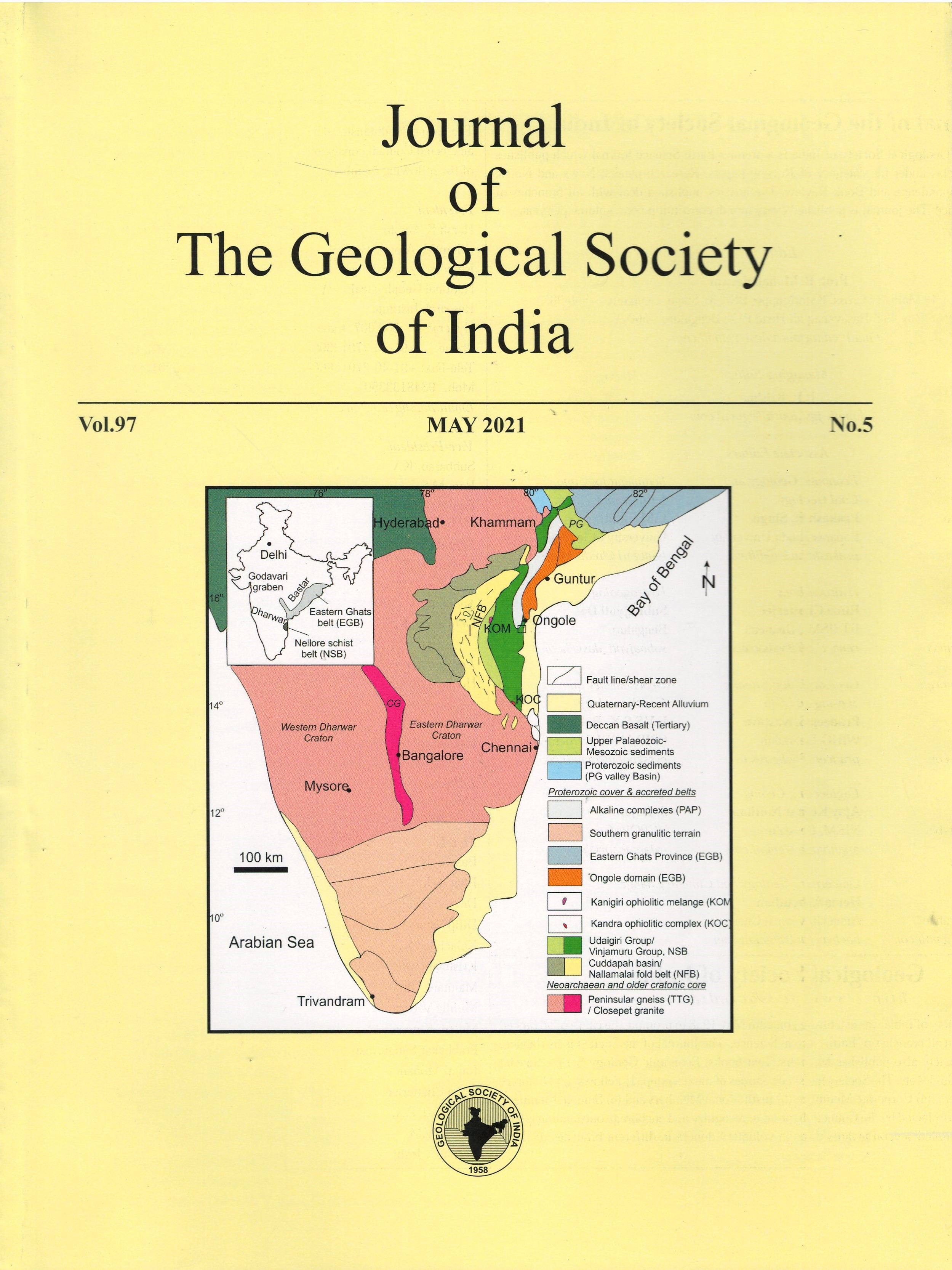Delineation of the Causative Fault of Recent Earthquakes (April-May 2020) in Delhi from Seismological and Morphometric Analysis
DOI:
https://doi.org/10.1007/s12594-021-1711-5Keywords:
No keywords.Abstract
Recently, amid the pandemic of COVID-2019, the north-east Delhi region experienced two small earthquakes in a short span of 1 month; the first occurred on 12th April 2020 (Mw 3.5) and the other on 10th May 2020 (Mw 3.4). These events were followed by 4 aftershocks of magnitude Mw £ 3.0. We carried out morphotectonic (high stream length-gradient index) and static Coulomb stress failure analyses to delineate the hidden causative fault(s) in the region. In the study, ASTER DEM data of 30 m resolution and Survey of India (SoI) toposheets on 1:50,000 scales were used for morphotectonic analysis. The analysis depicted a very high stream length-gradient (SL) and fall in elevation in the epicentral area, suggesting the area to be tectonically active with a NE-SW trending fault line. In addition, the nature of static Coulomb failure stress contours for both the main events, Mw 3.5 and Mw 3.4, suggests an NNE-SSW trending high Coulomb stress regime. Such a high coulomb stress regime is obvious at the location where a high SL index and fall in elevation were marked, which clearly indicates the presence of NNE-SSW trending a causative fault, named ‘Khanpur-Japti fault’.
Downloads
Metrics
Issue
Section
Downloads
Published
How to Cite
References
Bansal, B.K., Mohan, K., Verma, M. and Sutar, A.K. (2020) A Holistic Seismotectonic Model of Delhi Region, Scientific Reports (communicated).
Beeler, N.M., R.W. Simpson, S.H. Hickman, and D.A. Lockner (2000) Pore fluid pressure, apparent friction and Coulomb failure, Jour. Geophys. Res., v.105(B11), pp.25,533–25,542.
Clark, M.K., Schoenbohm, L.M., Royden, L.H., Whipple, K.X., Burchfiel, B.C., Zhang, X., Tang, W., Wang, E., and Chen, L. (2004) Surface uplift, tectonics, and erosion of eastern Tibet from large-scale drainage patterns. Tectonics, v.23(1), pp.TC1006.
Cocco, M. and Rice, J.R. (2002) Pore pressure and poro-elasticity effects in Coulomb stress analysis of earthquake interactions. Jour. Geophys. Res., v.107(B2), pp.1–17.
Das, S. and Scholz, C. (1981) Off-fault aftershock clusters caused by shear stress increase? Bull. Seismol. Soc. Amer., v.71, pp.1669-1675.
GSI (2000) Seismotectonic atlas of India and its environs. Published by Geological Survey of India, Calcutta.
Hack, J.T. (1973) Stream-profile analysis and stream-gradient index. Jour. Res. USGS, v.1(4), pp.421-429.
Harris, R.A. (1998) Introduction to special section: stress triggers, stress shadows, and implications for seismic hazard. Jour. Geophys. Res., v.103(10), pp.24347–24358.
Howard, A.D. (1967) Drainage Analysis in Geologic Interpretation: A Summation. AAPG Bull., v.51, pp.2246-2259.
Kachroo, K. and Bagchi, J. (1999) Report on the thematic mapping of the rocks of Delhi Supergroup in the National Capital Region Delhi. Unpub. Geol. Surv. India Report (FS: 1998-99).
Keller, E.A. and Pinter, N. (2002) Active Tectonics: Earthquakes, Uplift, and Landscape, 2nd ed. Prentice-Hall, Upper Saddle River, New Jersey, p.362.
King, G.C.P., Stein, R.S. and Lin, J. (1994) Static stress changes and the triggering of earthquakes. Bull. Seismol. Soc. Amer., v.84, pp.935-953.
Lin,J., and Stein, R.S. (2004) Stress triggering in thrust and subduction earthquakes, and stress interaction between the southern San Andreas and nearby thrust and strike slip faults. Jour. Geophys. Res., v.109, pp.B02303, DOI:10.1029/2003JB002607.
Pandey, A.P., Suresh, G., Singh, A.P., Sutar, A.K. and Bansal, B.K. (2020) A widely felt Tremor (ML 3.5) of 12 April 2020 in and around NCT Delhi in the backdrop of prevailing COVID-19 pandemic lockdown: analysis and observations, Geomatics, Natural Hazards and Risk, v.11(1), pp.1638- 1652, DOI: 10.1080/19475705.2020.1810785.
Pirasteh, S., Ali, S.A. and Hussaini, S. (2007) Morphometric and structural analysis in Zagros Mountains, Southwest Iran: An application of geoinformation technology. Jour. Geomatics, v.1(2), pp.39-44.
Strahler, A.N. (1952) Hypsometric (area-altitude) analysis of erosional topology, Geol. Soc. Amer. Bull., v.63(11), pp.1117–1142.
Stein, R.S. (1999) The role of stress transfer in earthquake occurrence. Nature, v.402, pp.605–609.
Sumy, D.F., Cochran, E.S., Keranen, K.M., Wei, M. and Abers, G.A. (2014) Observations of static Coulomb stress triggering of the November 2011 M5.7 Oklahoma earthquake sequence. Jour. Geophys. Res., v.119, pp.1904–1923.
Well, D.L. and Coppersmith, K.J. (1994) New empirical relationship among magnitude, rupture, length, rupture area, and surface displacement. Bull. Seismol. Soc. Amer., v.84, pp.974-1002.
Yamashina, K. (1978) Induced earthquakes in the Izu Peninsula by the IzuHanto-Oki earthquake of 1974, Japan, Tectonophysics, v.51, pp.139- 154.

 Brijesh K. Bansal
Brijesh K. Bansal






